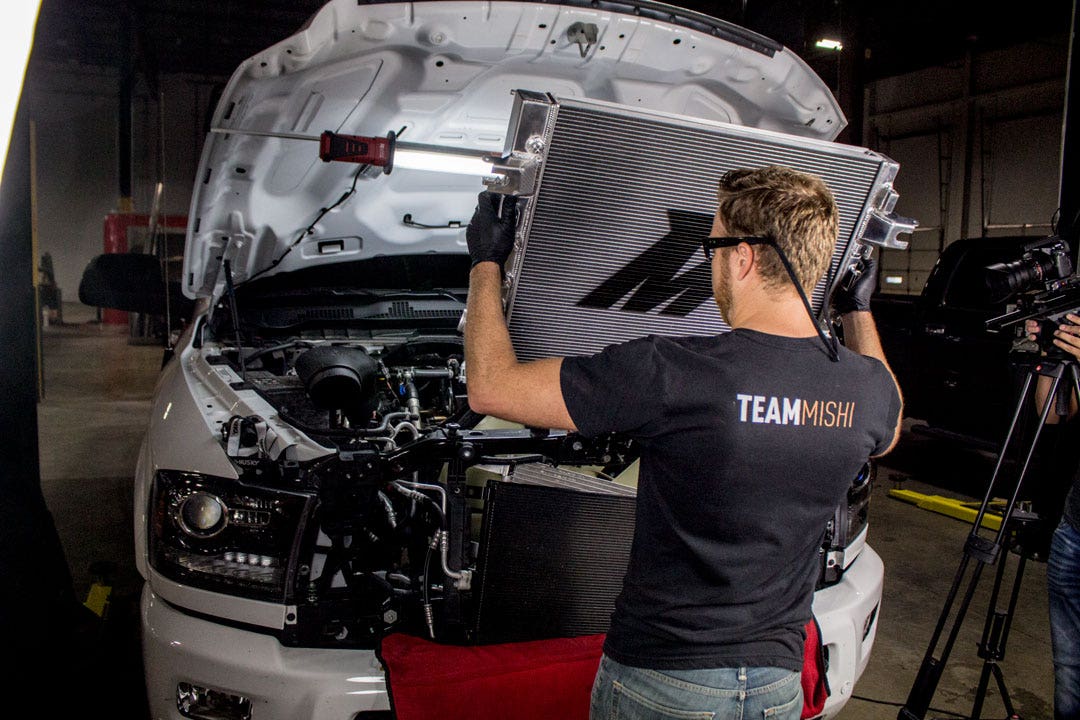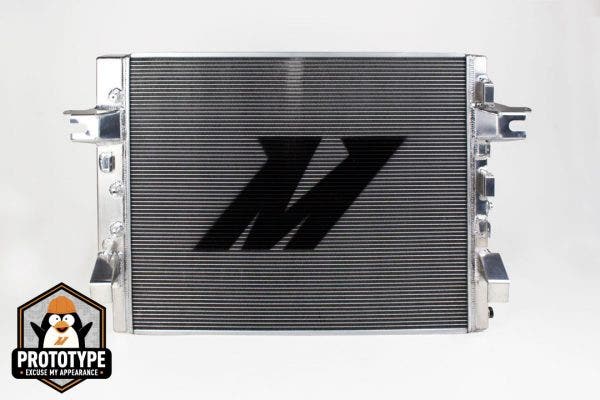
Cool Under the Blue Collar - Radiator R&D, Part 2: Prototype & Production
As the threads of the last bolt spun their way out, Jason hoisted the stock radiator out of the Ram's engine bay, over his head, and set it on the ground next to his workbench. With the radiator laying next to the truck, it was easy to see why we're making a replacement. The chiseled fenders and snarling grill of the 2017 Ram portray a truck built for power. The anemic core and plastic end tanks of the Ram's radiator, on the other hand, look like they come from a truck built to meet a budget.
Dodge's most popular truck is not just a vehicle to get from point A to point B; it's a tool built to do what any tool does best: work. Like any good tool, much of the Ram's design focuses on reliability and its ability to take abuse day after day. You'd be hard pressed to find an engine more durable than the 6.7L Cummins turbo-diesel found in the 4th generation Ram 2500 and 3500. But despite its legendary reliability, the 6.7 Cummins still relies on some less than bullet-proof support to get the job done.

While Dodge made updates to the 4th-gen Ram's cooling system to make it more efficient, even including two radiators from 2013-2014, the heart of the cooling system remained the bane of every aging or high-powered truck. Radiators with plastic end tanks are a cost-effective way to produce thousands of vehicles that meet the needs of the majority of Dodge's customer base. The 4th-gen radiator is no slouch and keeps up well with the duties a stock truck performs. But as any enthusiast knows, these trucks don't stay stock for long, and with more power comes more heat. Add the wear and tear of hundreds of heat cycles, and those plastic end tanks are a ticking time bomb. Ask anybody who owns a 2013 or 2014 Cummins powered Ram about their plastic y-pipe and you'll find out just how quickly that plastic can break down.
That's why, for the past few months, our engineers and fabricators have been designing, welding, and 3D printing their way to a better Ram radiator. Since our last update, we've made strides towards a finished product, so we have quite a lot to cover in this post. With the stock radiator analyzed and its weaknesses determined, Jason began working on our aluminum replacement.

Like many of our radiators, Jason started by creating a 3D computer model based on the measurements he'd taken from the stock radiator and the engine bay of the Ram. It's important that the end tank design matches the stock radiator. Of course, a larger core will often require a larger end-tank, but the inlets, outlets, mounts, and any other accessory locations must remain in their original location to ensure a factory fit.

To be sure that his measurements and design were spot-on, Jason sent the end tanks to the 3D printer to make a full-size prototype. Since no coolant would be flowing for the dry test fit, a piece of high-density foam, cut to the final dimensions of the core, filled the space between the end tanks and kept everything in line. A few bolts and hose clamps later, our prototype was fully installed and the fit confirmed.

In the wake of a successful prototype test fit, the 3D model went over to our drafters to be converted into 2D drawings that could be used to manufacture a functioning, all-aluminum radiator. Those drawings turned into our production sample, ready to be, once again, test fit into a loaner truck.

A three-row core that's about a half-inch thicker than stock meant all the hoses and mounts needed to line up without any leaks or clearance issues. A dry fit wasn't going to cut it. So, with our much larger, all-aluminum radiator close by, Jason pulled the hood release on the bright white 2017 Ram waiting in his bay. The hood latch released with a solid thud and as the hood swung open, the lowly stock radiator was revealed. With no rust or corrosion to slow him down, Jason made short work of removing the stock unit. Installing our sample was just as easy and the radiator that was once made from plastic and high-density foam, translated perfectly into aluminum. All that was left was to fill the radiator with coolant and get it up to temp to check for leaks.

A dry shop floor and a running truck signaled to Jason that his design had passed the test. Our 2013+ Ram Cummins radiator was ready for full production. It's been a long road, longer than this post, if you can believe it. But, it's almost time for the pre-sale, so keep an eye out over the next couple weeks for the announcement and your chance to get this rad at a deep discount.
Thanks for reading,
-Steve




